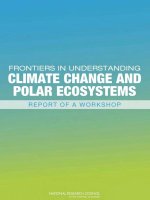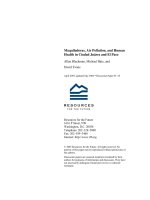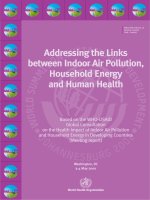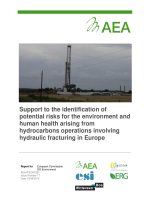Tiểu luận Climate Change and Human Health
Bạn đang xem bản rút gọn của tài liệu. Xem và tải ngay bản đầy đủ của tài liệu tại đây (65.48 KB, 6 trang )
Vu Tuan Tai
K55TTKHMT
10000792
Report
Climate Change and Human Health
Abstract: As we all know, greenhouse gas emissions generated by human activity will change
Earth’s climate. The recent globally averaged warming by 0.5ºC is partly attributable to such
anthropogenic emissions. Unfortunately, climate change may impact adverse affects on human
health through a range of pathways. For instance, we normally consider the increased frequency and
intensity of heat waves, polluted air, increased floods and droughts, changed in the distribution of
vector-borne diseases and the risk of extreme disasters and malnutrition. Finally, prevent is nearly
better than cure, therefore we can mitigate the impact of climate change by reducing the use of
fossil fuels and increasing the use of a number of renewable energy technologies should improve
health in the near term by reducing exposure to air pollution.
1. Introduction
According to The Intergovernmental Panel on Climate Change (IPCC 2001), drawing on the published
results of leading modeling groups around the world, the scientists forecast an increase in global
average temperature by 2100 within the range 1.4 – 5.8ºC. The increase will be greater at higher
latitudes and over land. Global average annual rainfall will increase, although many mid latitude and
lower latitude land regions will become drier, whereas elsewhere precipitation events and flooding
could become more and more severe. Climate variability is expected to increase in a warmer world
today. A fundamental global environmental change, affecting physical systems and ecosystems, will
affect human health in many ways. However, many details are debated. What health effects will
occur for human?
2. Climate change impact on human health
There are several mechanisms by which climate change can affect human health. Extremes of
temperature and rainfall - e.g. heat waves, floods, and droughts have direct immediate effects on
mortality as well as longer-term effects. Moreover, populations that have experienced flooding may
suffer from sustained increases in common mental disorders. In addition, climate change is also
likely to affect biodiversity and the ecosystem goods and services that we rely on for human health.
Changes in temperature and rainfall may also affect the distribution of disease vectors—e.g. those of
malaria and dengue—and the incidence of diarrhoeal diseases.
2.1 Extreme heat and cold
Extreme weather events such as heat waves and cold spells lead to mortality ratios 10% or higher
than for average temperatures (Huynen et al. 2001). Typically, weather stress does not kill
directly; instead, it is a “last straw” of additional stress for people with other conditions such as
heart or lung disease. The elderly and infirm are therefore at greater risk, as are those individuals
exposed to thermal stress via their occupation (e.g. outdoor laborers). Much of the excess mortality
from heat waves is related to cardiovascular, cerebrovascular, and respiratory causes and is most
1
concentrated in elderly people. Extreme heating, and therefore its negative effects, are exacerbated
by the “urban heat island”. This term describes the well-known climatic effects of urbanization that
lead to cities being warmer than the surrounding areas, especially overnight (Comrie 2000). Daily
minimum temperatures can be 5°C or more warmer, meaning fewer winter frosts, an earlier
thermal springtime , and of course higher overnight minimum temperatures in summer.
Depending on the city and humidity levels, the latter can reduce the relief from daytime high
temperatures and increase weather stress. Climate model projections of overnight lows for the
next century show the warmest night of the year increasing by 10°C (Christidis et al. 2005),
before accounting for the additional urban heat island effect in cities. While local conditions may
modulate these projections higher or lower, the overall potential for increases in heat deaths is high.
Location (date)
England, Wales (Aug 4-13)
Italy (Jun 1-Aug 5)
France (Aug1-20)
Portugal (Aug)
Spain (Jun-Aug)
Switzerland (Jun-Sept)
Excess mortality (%increase)
2091 deaths (17%)
3134 (15%)
14802 (60%)
1854 (40%)
4151(11%)
975 (6.9%)
References
Johnson et al
Conti at al
Anon
Botelho et al
Simon et al
Grize et al
Table 1: Excess mortality attributed to the 2003 heat wave in Europe
2.2 Air pollution
Connections between air quality and health have been known for a long period of time ,
although the precise effects of specific pollutants are still actively researched (Pope et al.
2002). Health effects were self-evident from the thousands of deaths in the infamous London
smog of the 1950s (about 4000 were estimated for the December 1952 smog), when smoke
concentrations were tens and even hundreds of times higher than today (Harrison 2006). Higher
temperatures increase ground-level ozone pollution (Patz et al. 2001), because the chemical
reactions that produce ozone from its precursor pollutants proceed faster under warmer
conditions. If cloud-free conditions increase, then more available solar radiation will further
increase ozone levels. Ozone health effects include breathing problems, airway inflammation, and
reduced resistance to infections. Climate change projections indicate the likelihood for a longer ,
more severe, and more widespread high-ozone season each year (Fiore et al. 2002; Hogrefe et al.
2004).
2.3 Floods, storms and droughts
Natural disasters have a variety of human health impacts, ranging from immediate effects of physical
injury and morbidity and mortality through to potentially long-lasting effects on mental health. In
1997, river floods in central Europe left over 200,000 people homeless, and more than 100 people
were killed. Following floods, increases in diarrhoeal and respiratory diseases are reported in both
high-income and low-income countries; transmission is increased where there is crowding of
displaced populations. In industrialised countries, although infections are much less of a problem,
the impact on the local economy may still be severe and increases in common mental disorders such
as anxiety and depression are common. These increases are probably related to damage to the
home environment and economic losses and may persist for more than a year after flooding. In US
2
history, over 1800 deaths, approximately 2000 injuries and more than 1 million displaced people
resulted from Hurricane Katrina on August 2005, which is now one of the most expensive and
deadliest natural disasters (Zimmermann 2012). Droughts may have wide ranging effects on health
including on nutrition, infectious diseases, and on forest fires causing air pollution, particularly in
low-income countries. The number of people worldwide affected by drought is influenced strongly
by the El Niño cycle.
2.4 Infectious diseases
Transmission of many infectious disease agents is sensitive to weather conditions, particularly those
spending part of their life cycle outside the human body. Pathogens that are carried by insects are
exposed to ambient weather. Vector-borne diseases typically exhibit seasonal patterns in which the
role of temperature and rainfall is well documented. Some vector-borne diseases, such as malaria,
also display considerable year-to-year variation in some regions that can also be partly explained by
climatic factors such as temperature, humidity, sea level rise.
Vector
Mosquitoes
Sandflies
Triatomines
Ixodes ticks
Blackflies
Major diseases
Malaria, yellow fever
Leish maniasis
Chagas disease
Lyme disease
Onchocerciasis
Table 2: Examples of vector-borne diseases likely to be sensitive to climate change
Precipitation and temperature fluctuations can directly impact pathogens and diseases in water and
food. Natural flood events cause increases in fecal bacteria (Escherichia coli) as water levels rise and
debris is washed into the stream. Higher mean temperatures lead to more monthly Salmonellacases
(WHO 2003), most likely resulting from improper refrigeration and exacerbation of food
contamination. Water-borne pathogens are numerous and widespread; some examples include
cholera, cryptosporidium, rotaviruses, Coxsackie viruses, hepatitis A and E viruses. Health risks
range from wound infections to diarrhea and organ failure (Rose et al. 2001).
2.5 Malnutrition
Attribution of current and future climate-change-related malnutrition burdens is problematic
because the determinants of malnutrition are complex. Due to the very large number of people that
may be affected, malnutrition linked to extreme climatic events may be one of the most important
consequences of climate change (IPCC 2007). For example, climate change is projected to increase
the percentage of the Malian population at risk of hunger from 34% to between 64% and 72% by the
2050s, although this could be substantially reduced by the effective implementation of a range of
adaptive strategies (Butt et al., 2005). Climate change models project that those likely to be
adversely affected are the regions already most vulnerable to food insecurity, notably Africa, which
may lose substantial agricultural land. Overall, climate change is projected to increase the number of
people at risk of hunger.
3
Adverse health effects
Heat-related illnesses
and deaths
Changes in intermediate factors
Natural and
human
influences
on climate
Climate
variability
and change
Regional
and local
weather
change
Mitigation
policies
Change in sea level
Extreme weather-related
health effects
Air pollution
concentration and
distribution
Air pollution-related
health effects
Pollen production
Allergic diseases
Microbial contamination
and transmission
Infectious diseases
Water-borne and
food-borne diseases
Vector-borne and rodentborne diseases
Crop yield
Malnutrition
Coastal flooding
Coastal aquifer salinity
Storm surge-related
drowning and injuries
Health problems of
displaced populations
Modulating
influences and
adaptation
measures
Diagram 1: Summary the potential health effects of climate change (reproduced from Haines A, Patz
J. “Health effects of climate change”. JAMA2004; 291:99–103).
4
3. Conclusion
Prevention is nearly always better than cure. There is an urgent need to develop improved methods
and tools of climate impact assessment (such as the use of probabilities and Bayesian analysis)
within a precautionary framework.
The effects of climate change on health are likely to be predominately negative and impact most
heavily on low-income countries where capacity to adapt is weakest, but also on the most
vulnerable groups in developed countries. Adaptation strategies should blunt some of the adverse
impacts but will pose difficulties of implementation, particularly in low-income countries. With
climate change already underway, there is a need to assess vulnerabilities and identify cost-effective
intervention/adaptation options in the health sector and in other sectors that have direct links to
human health. Early planning can help reduce future adverse health impacts and mitigation
strategies such as using a number of renewable energy sources can improve health by reducing air
pollution as well as addressing climate change.
References
5
1. IPCC. Climate change 2001: the scientific basis.
Contribution of working group I to the third assessment
report of the Intergovernmental Panel on Climate
Change. Cambridge: Cambridge University Press, 2001.
2. World Health Organization (WHO 2003). Climate
change and human health-risks and responses.
3. Huynen, M.M. T . E., et al. (2001). The impact of heat
waves and cold spells on mortality rates in the Dutch
population. Environment Health Perspectives109, pp.
463–470.
4. Comrie, A. C. (2000). Mapping a wind-modified urban
heat island in Tucson, Arizona (with comments on
integrating research and undergraduate learning).
Bulletin of the American Meteorological Society81, pp.
2417–2431.
5. Christidis, N., et al. (2005). Detection of changes in
temperature extremes during the second half of the
20th century Geophysical Research Letters 32, L20716.
6. Johnson H, Kovats RS, McGregor G, et al. The impact
of the 2003 heat wave on mortality and hospital
admissions in England.
7. Conti S, Meli P, Minelli G, et al. Epidemiologic study of
mortality during the summer 2003 heat wave in Italy.
Environ Res2005; 98:390–99.
8. Anon. Impact sanitaire de la vague de chaleur en
France survenue en août 2003. Paris: Institut de Veille
Sanitaire, 2003.
9. Botelho J, Caterino J, Calado R, Nogueira PJ, Paixao E,
Falcao JM. Onda de calor de Agosto de 2003. Os seus
efeitos sobre a mortalidade da populacao portuguesa.
Lisbon: Instituto Nacional de Saude Dr. Ricardo Jorge,
2005.
10. Simon F, Lopez-Abente G, Ballester E, Martinez F.
Mortality in Spain during the heat waves of summer
2003. Euro Surveill 2005; 10:156–60.
11. Grize L, Hussa A, Thommena O, Schindlera C, BraunFahrlandera C. Heat wave 2003 and mortality in
Switzerland. Swiss Med Wkly2005; 135:200–05.
12. Pope, C. A., et al. (2002). Lung cancer,
cardiopulmonary mortality , and long-term exposure to
fine particulate air pollution. Journal of the American
Medical Association 287, pp. 1132–1141.
13. Harrison, R.G. (2006). Urban smoke concentrations
at
Kew,
London,
1898–2004.
Atmospheric
Environment40, pp. 3327–3332.
14. Patz, J. A. et al. (2001). Potential consequences of
climate variability and change for human health in the
United States. Chapter 15 in National Assessment
Synthesis Team, Foundation document of Climate
change impacts on the United States. Washington, DC:
US Global Change Research Program, pp. 437–458.
15. Kim Ann Zimmermann, LiveScience contributor.
Hurricane Katrina: Facts, Damage and Aftermath. 2012.
16. Fiore, A. M., et al. (2002). Linking ozone pollution
with climate change: the case for controlling methane.
Geophysical Research Letters 29, 1919.
17. Hogrefe, C., et al. (2004). Simulating regional-scale
ozone climatology over the eastern United
States: model evaluation results. Atmospheric
Environment38, pp. 2627–2638
18. Rose, J . B., et al. (2001). Climate variability and
change in the United States: potential impacts
on water-and food-borne diseases caused by
microbiologic agents. Environment Health Perspectives
109(Suppl 2), pp. 211–221
19. Butt, T., B. McCarl, J. Angerer, P. Dyke and J. Stuth,
2005: The economic and flood security implications of
climate change in Mali. Climatic Change,68, 355-378.
20. Haines A, Patz J. “Health effects of climate change”.
JAMA2004; 291:99–103.
21. IPCC 2007. Volume 2: Impacts, adaptation and
vulnerability.
6









